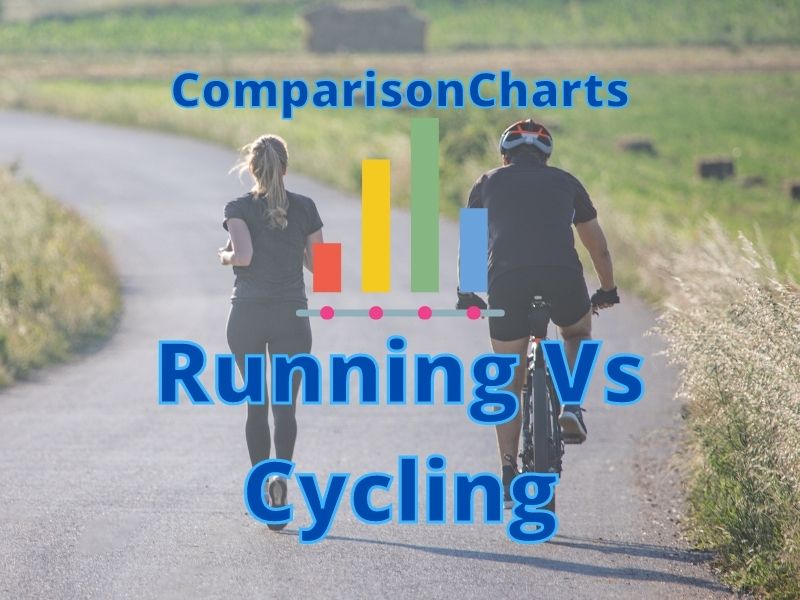If you like to run and cycle, you can get more variety in your exercise routine. I enjoy both activities, although I don’t go biking often. Yet, biking can have some of the same benefits as running and tends to have a lower impact on your joints.
When comparing running and cycling, the health benefits can be equally as good. You’re improving your overall health and leg muscle development. The differences relate to how runners and cyclists use their legs and bodies and what happens as a result.
I definitely have more fun riding my mountain bike on a trail than running on a trail. There are pros and cons to both. Your opportunity to run or bike may be limited by circumstances, but doing both is one way to add variety to your exercise, which may decrease your likelihood of injury.
Running – What are the Benefits?
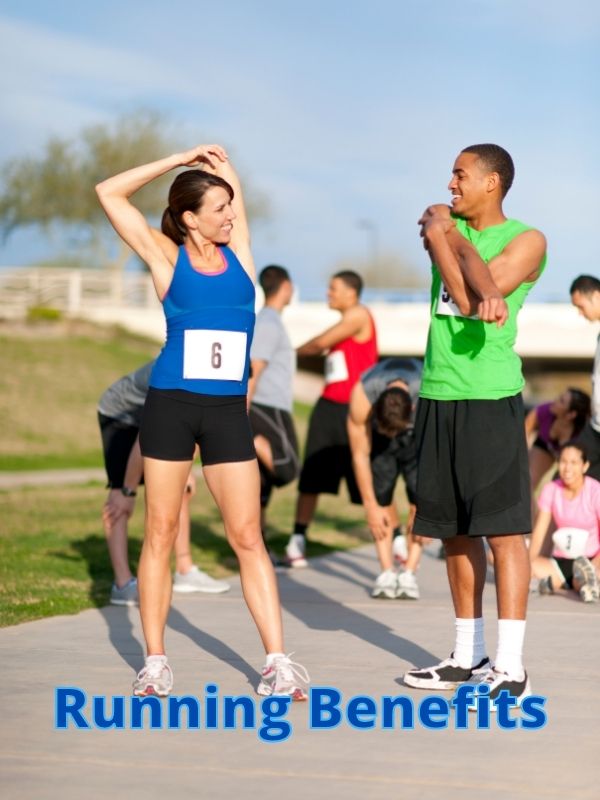
Running is a great way to get a good cardio workout. You can vary the pace of your run, the time spent running, and elevations that you run. These can improve your performance and endurance as a runner. Yet, runners can’t reach their full potential if they don’t take time to do other exercises, such as strengthen their leg muscles.
Here are 10 benefits you can receive from running:
- Can circulate blood more effectively. The amount of oxygen your body can use (VO2 max) can remain higher for longer with regular cardio exercise.
- Can help improve your mood when running regularly. Can help fight depression.
- Can help you develop stronger arches with the correct shoes.
- Improves your cardio and heart strength and ability to accomplish many types of exercises.
- Helps with endurance.
- Overall health, such as disease prevention and immune system boost.
- Sleep better
- Improved joints (if not overdoing it)
- Burn calories. Maintain your weight better.
- Lowers blood pressure.
Cycling – What are the Benefits?

When I go cycling, there are times of intense effort and times of rest. It can be lots of fun going downhill after a long climb uphill. When you cycle you are getting a good cardio workout and helping your legs get stronger. Yet, cyclers can’t reach their full potential unless they take time to do other exercises to strengthen their leg muscles.
Here are 10 benefits you can receive from cycling:
- Your heart can pump lots of oxygen to more areas of your body better. You can get more nutrients and energy. You can raise your VO2 max with regular exercise.
- Can help improve your leg muscle strength.
- Can help you improve your balance and coordination.
- Improves your cardio and heart strength and ability to accomplish many types of exercises.
- Helps with endurance.
- Overall health, such as disease prevention and immune system boost.
- Improves your mood. Most cardio exercises will help boost feel-good chemicals.
- Improved joints (if not overdoing it)
- Burn calories. Maintain your weight better.
- Lowers blood pressure.
Running and Cycling Similarities and Differences
When you run or cycle you are using your legs and core muscles but in different ways. The effects of running and cycling are different over several miles. One uses a machine to move, while the other relies mostly on their legs. If we compare the two activities we can see how similar and different they are.
Characteristics of Running and Cycling
Similarities of Both
- Develop strong leg muscles
- Great for a cardio workout
- Overall health improved
- Endurance gained equally from both
- Increases brain health – Improved memory and a better mood.
Running Differences
- High impact on joints
- Burns ~600 calories per hour
- Stronger bones
- High Vo2max
- Injuries from running are common ~65% each year
Cycling Differences
- Low impact on joints
- Burns ~800 calories per hour
- Weaker bones
- Fairly High Vo2max
- Injuries from cycling are less common but some are fatal ~28% may have a knee injury and 2.1% of all traffic accidents are cyclists
Summary:
Each activity has its pros and cons, but a combination of both can give you the best of both worlds. If you have done cross-training, you know that you get to do a wide variety of exercises. This variety can help you avoid injury because you are building a variety of muscles in many ways and hopefully not over-stressing your body by focusing only on one activity.
Joints Health When Running Vs Cycling
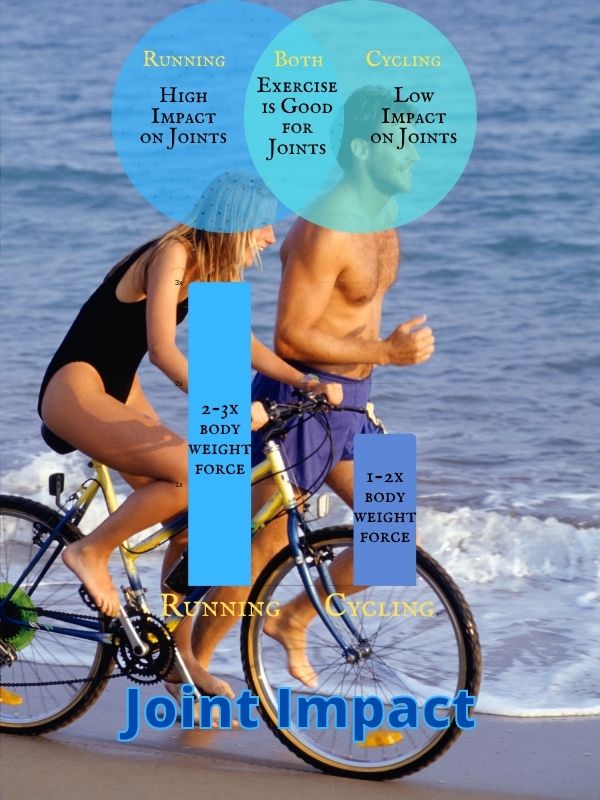
Information Gather From YouTube
Your joints are constantly breaking down cartilage and building it back up. Joint provides cushioning and lubrication between your bones so you can run and cycle with comfort.
Running and cycling can put stress on the joints and may cause knee pain, yet exercises like these are also very healthy for your joints because they activate healing and waste removable when they are used often.
In my article about arthritis you can see how important moving is for your joints, but overworking any part of your body may start to cause injuries to occur.
So, for cyclists and runners, a recovery period is important. In addition, taking the time to build muscle to strengthen your legs is also important for joint protection. That way your muscles can take the stress off your joints.
Running can have 2-3x the force of your body weight on some joints when you are running, while I estimate that cycling should only have 1-2x the force of your body weight on your joints.
Here’s a video that shows the ground force of many types of runners. They impact the ground with a force of 2x their body weight or more as they run. This stress on their legs leads to bone growth, especially in sprinters but can also lead to injuries if runners are not careful.
Letting cartilage build back up may help prevent injury for some runners. That’s why doing other activities besides running, like cycling, can be helpful for short periods to give the joints a low-impact workout that still provides nutrients to the joints and promotes healing.
Calories Burned Running Vs Cycling
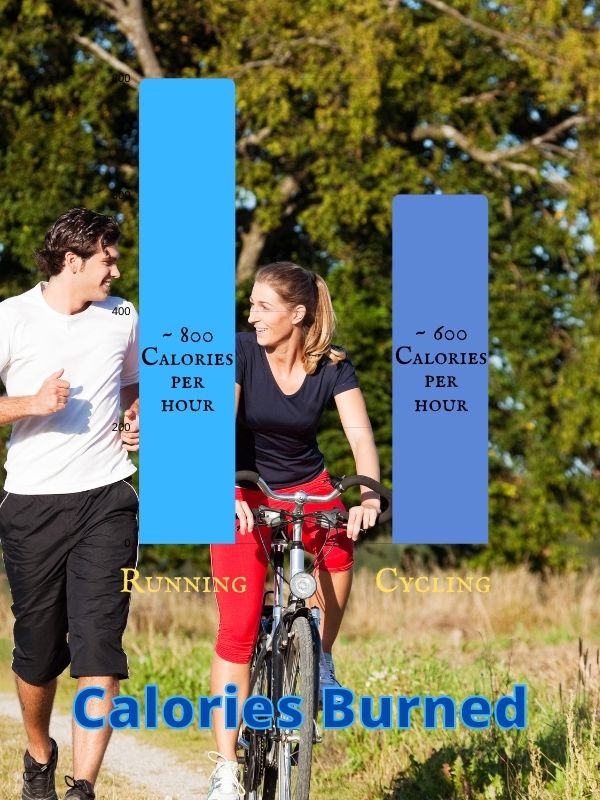
If you are working on maintaining your weight, exercise can be an important factor in helping you achieve your goals. With a healthy diet, you can gradually lose weight. The muscles are conditioned over time and start to change on the genetic level, and this can also help your muscles burn energy effectively.
For the average person, running can burn about 800 calories per hour. While the average person can burn about 600 calories per hour cycling. The number of calories varies quite a bit for different people and various levels of intensity, but these numbers give you a general idea about how the two activities compare.
Running and cycling will create a healthy body over time. What’s important is to be consistent and take care of your legs by resting them when needed. getting them moving when they’ve been sedentary, and providing them with nutrients and blood flow by doing cardio and eating well.
Bone Health – Running Vs Cycling

When I was a kid we would have jump rope contests at school. I enjoyed seeing how long I could go without stopping. Later, I learned that jumping helps cause very small bending of the bone, making them stronger over time.
We know now that running can also increase the bone density of individuals who run often. Yet, cycling can have the opposite effect on the bones, even though cyclists are just as fit as runners. So what’s happening?
Running requires that the bones are impacted over and over, causing them to grow stronger in response. Cyclists are not putting much pressure on the bones or causing them to bend much.
When it’s time to rest their legs, runners can stay off their legs and still have bone growth during recovery, yet cyclists who put little pressure on the legs continue to stay off their legs during recovery causing no bone growth.
Over time, the bones in runners get stronger and the bones in cyclists may get weaker. According to one study, “23% greater bone mass than people who don’t exercise.” (blog.mapmyrun.com) While another study found that the bone mineral density “of lumbar vertebral of Tour-de-France cyclists was 10% lower than BMD of non-athletes.” (researchgate.net)
Again, we see the need to vary the activities of cyclists to include a variety of exercises that enhance overall leg health.
Oxygen Intake – Running Vs Cycling
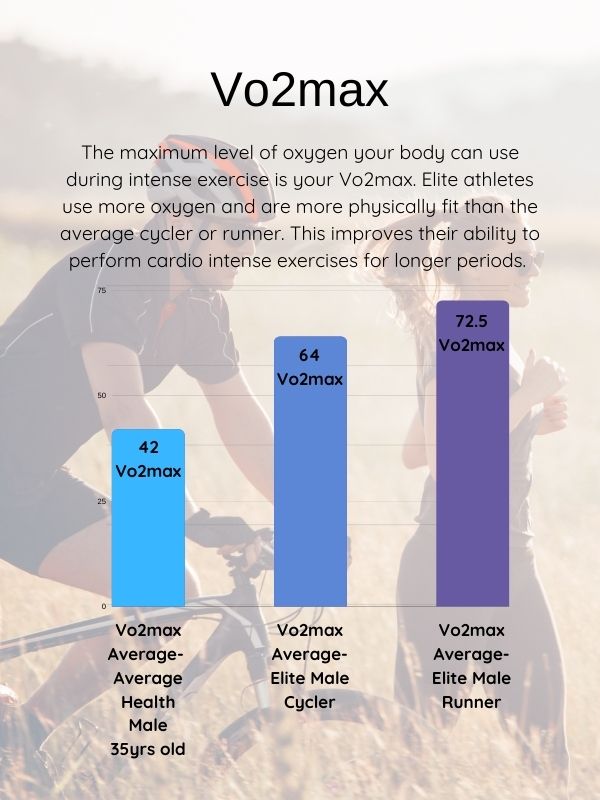
Data from slideshare.net
How our body uses oxygen changes based on how we exercise. An average person who exercises enough to remain in average physical health can expect to have a Vo2max around 42 for 35-year-old males. This number represents a normal healthy number for oxygen intake.
If you have an Apple watch, you can use it to record your Vo2Max. In an article on cultofmac.com, you can get information on what your number is. Just be ready to work hard for about 20 minutes.
Those who have high Vo2max numbers bring a higher level of health to their bodies. Elite cyclists and runners have high Vo2max numbers. Getting more oxygen into our bodies is essential during exercise and is helpful during recovery as well.
Injury Rate – Running Vs Cycling

The rate of injury for runners is generally higher than for cyclists. Running gives you a lot of chances to have strong impacts and strains if you’re not careful, while cycling doesn’t necessarily have the same level of strain on the legs.
Yet, most professional cyclists will have overuse injuries sometime within a year. So, like runners, cyclists can have as much injury as runners depending on circumstances.
One thing that cyclists need to be very cautious about is traffic. Cyclists comprise 2.1% of all traffic accidents in the US. And each year more and more male cyclists over the age of 20 are killed each year from these accidents. Thankfully the opposite is true for children cyclists; fewer and fewer each year get into traffic accidents.
To prevent accidents and injuries from occurring, we need to take precautions, such as watching intersections, wearing helmets, limiting our time exercising, and getting the rest we need.
So, my takeaway from this article is that both runners and cyclists can benefit a lot from being involved in both riding and running activities, they just need to be cautious when doing them.
Injuries for both activities can occur for both, especially with overuse of their legs. Therefore, strengthening legs and getting involved in a wide variety of exercise activities can help counteract some of the problems that occur when only focusing on one type of exercise.
References
https://www.podiumrunner.com/culture/10-amazing-benefits-running-might-not-known/
https://www.ncbi.nlm.nih.gov/pmc/articles/PMC4551211/
https://www.slideshare.net/jaravis/what-is-vo2max
https://www.womenshealthmag.com/fitness/a26306128/cycling-vs-running/
https://www.trainingpeaks.com/blog/why-cycling-is-bad-for-bone-density-and-how-you-can-improve-it/
https://www.rosenthalinjurylaw.com/bicycle-accident-statistics/
https://www.sciencedaily.com/releases/2009/02/090227080005.htm
https://blog.mapmyrun.com/want-stronger-bones-go-running/
https://www.cyclingweekly.com/fitness/cycling-knee-pain-everything-you-need-to-know-329957

